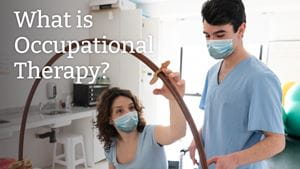
April marks Occupational Therapy Month, a time to celebrate the therapists who work so diligently with people of all ages and backgrounds in our community each day.
Occupational Therapy Month is also a great time to explain what occupational therapy (OT) is, how it works, and the unique ways OT specialists work with their patients.
Carol Van Bork, OTR/L, CHT, is an occupational therapist with Rochester Regional Health and has answers to some common questions about OT and its benefits to daily life.
Occupational therapy is a branch of medicine that brings together purposeful activities with evidence-based science.
Through their practice, occupational therapists partner with patients to develop, improve or restore independence by focusing on activities of daily living. They also work to help them regain the ability to engage in activities that have personal meaning and value.
OT takes a whole person-centered approach to therapy, meaning they focus not only on areas of physical improvement, but also improving the areas of psychosocial, visual, behavioral, cognitive, hearing, neuromuscular, and musculoskeletal development, as well as developmental disabilities, and mental health.
“Each day, occupational therapists strive to figure out not only what each individual needs to do for their level of performance in a certain area, but how to supplement that effort with purposeful activities when possible,” Van Bork said.
Occupational therapists currently hold a master’s degree at minimum, with a growing number of OTs achieving their doctoral degrees.
In addition to time spent working toward a master’s degree in an academic setting, each individual will spend 6-9 months conducting clinical field work. Placements for field work range anywhere from 1 week to 3 months at a time.
Beyond these degrees, there are a wide variety of specialty areas in which OTs can be trained and certified. These include, but are not limited to:
By taking the time to continuously learn from and strategize with each individual, OTs create a plan to help each individual improve the desired life skills that come with activities of daily living (ADLs).
Therapists are able to work with patients to help them adapt to both injury-specific situations and for general life situations. Each one is specific to the patient based on their injury or health condition.
These ADLs have a wide range and may include:
Creating goals centered around ADLs go beyond physical tasks. OTs also work with patients to develop psychosocial skills, which can include completing tasks such as ordering a pizza over the phone or paying for items in a checkout line at a store.
“There is a lot of creativity involved for each individual case,” Van Bork said.
At the first assessment or evaluation, OTs will perform several evaluations. Each of these are dependent on the patient’s health condition or injury which led them to their OT referral.
Generally, the patient will be asked about the nature of their work, leisure interests, preferences, and other questions to give the OT team a sense of the areas in which they need to focus.
OTs will also take note of different criteria related to the affected area of the body, such as:
“With every patient, we ask them to tell us what they can and cannot do,” Van Bork said. “We need to know how difficult certain tasks and activities are and what you want to be able to do so that we know what areas we need to focus on.”
Additional methods of testing may be used depending on the nature of the patient’s condition. For example, if a patient has Parkinson’s disease or multiple sclerosis, their assessment would use other forms testing compared to a patient with an acute injury such as a broken wrist.
The professions of occupational therapy and physical therapy are similar in many ways. In their schooling, many future providers will take many of the same classes for both OT and PT.
Physical Therapy is a medical field that focuses on treating patients who have experienced illness or injury that has resulted in pain, muscle weakness or decreased range of motion. They are movement experts who optimize quality of life through prescribed exercise, hands-on care and patient education. PTs focus on restoring ability to move, reducing pain, and preventing further injury.
Occupational therapy focuses comprehensively on the whole person. They consider the whole person and develop therapies that take into account physical, emotional and environmental factors that affect participation and performance in meaningful activities. They look at the performance of the whole person and are centered on restoring an individual’s ability to perform daily tasks independently.
Since the nature of occupational therapy allows for so much adaptation and creativity, this permits OTs to serve patients of all ages.
With the exception of acute injuries, most children have access to OT through their public school districts instead of a healthcare system. Children can be referred by educators, physicians, and parents for assessments, which vary based on age. These assessments help educators, therapists, and parents determine if a child may need some therapies in areas of speech, visual perception, cognition, fine motor skills, gross motor skills, sensory processing, or other areas of development.
Adults are more often referred directly by their primary care provider or a specialist.
One strategy that overlaps for both children and adults is the idea that OT should not be a chore but should be an interesting and engaging way to restore function for a patient.
“Regardless of age in life, we want to find an interest or hobby for each patient to make the therapy engaging and interesting instead of feeling like work all the time,” Van Bork said.